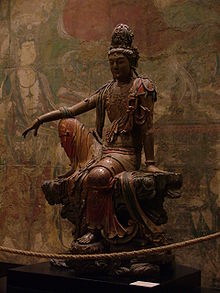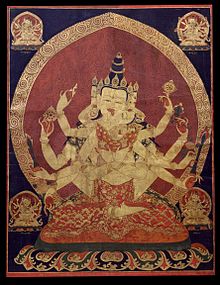Guanyin
This is the sighted version that was marked on May 25, 2021. There is 1 pending change that needs to be sighted.
![]()
The title of this article is ambiguous. For other meanings, see Guanyin (disambiguation).
![]()
This article is not sufficiently supported by evidence (e.g., anecdotal evidence). Information without sufficient evidence may be removed soon. Please help Wikipedia by researching the information and adding good evidence.
For details (problematic passages) see Discussion:Guanyin#evidence missing.
Guanyin (Chinese 觀音 / 观音, Pinyin Guānyīn, W.-G. Kuan-yin) is a female bodhisattva of compassion in East Asian Mahayana Buddhism, but is also worshipped as a goddess in popular belief, originally being the male bodhisattva Avalokiteshvara.
Guānyīn is the Chinese variant of the Bodhisattva Avalokiteshvara. In Japan she is known as Kannon (観音), in Vietnam as Quan Âm or Quan Thế Âm Bồ Tát; in Korea as Kwan Seum Bosal (also: Kwan-um or Kwan-se-um). Another, older name for it is Guānzìzài (觀自在 / 观自在, jap. Kanjizai).
One of the most revered figures in East Asian Buddhism, she is found numerous times in iconography, texts, and practiced religion. Kannon is the most popular deity in the Buddhist pantheon. Since the arrival of the cult in Japan at the end of the 6th century, people have sought comfort and happiness from her.

Wooden statue, later Liao dynasty, Shanxi province
Etymology
觀 / 观, guān is the character for "to look at, to look at, to take a look at something", or "view, view", 音, yīn is "sound, sound, sound". The name Guānyīn (Jap. Kannon, kor. Gwan-eum) is short for Guānshìyīn (觀世音 / 观世音, Jap. Kanzeon, kor. Gwan-se-eum) and means "perceiving the sounds of the world".

Statue of the Guanyin in Mueang Boran in Thailand

Statue of the Guanyin in the monastery Shuanglin Si in Pingyao

Tibetan Thangka: Guhyasamâja-Avalokiteshvara Ming Dynasty 17th century

Porcelain statue, Ming Dynasty
Origins
Although Guanyin is often associated with Buddhism, the deity also plays an important role in Daoism. It is already mentioned by Liezi, who lived in the 3rd century BCE, long before Buddhism came to China.
The Lotus Sutra from Mahāyāna Buddhism has been translated into Chinese several times. The most important translation is by Kumarajiva and was completed in 406. Here the name of the bodhisattva Avalokiteshvara was translated from Sanskrit into the Chinese name Guānshìyīn.
Guānyīn takes a central role in the Heart Sutra.
In China, many statues were created. At first, according to the translation, Guānyīn was depicted as a man. As it spread throughout the country, the content of the sutra was often mixed with existing religious beliefs and practices.
In the Táng dynasty (618 to 907) tolerance prevailed and there were intense encounters of many religions. The Lotus Sutra was very popular because of its emphasis on compassion. But especially in popular piety, there was a great need for a deity with feminine attributes. A popular goddess of the time was Xīwángmǔ, the Queen Mother of the West from Daoism. The blending of these and other religious ideas over time gave rise to the "goddess" Guānyīn, who in the Lotus Sutra can take on 33 different roles, seven of which are female.
During the Song dynasty from the 10th to the 13th century, Guānyīn in northwestern China was increasingly depicted as a woman. In the 12th century, ancient stories of goddesses and heroes were also associated with Guānyīn in religious centers.
When Portuguese Jesuits came to China in the late 16th century, Chinese artists considered the Madonna statues to be representations of Guānyīns and began to make new statues based on this model.
Other representations of Guānyīn are based on Avalokiteshvara. She has many eyes so that she can see suffering everywhere in the world, and many arms so that she can help everywhere. Literarily, she is described as having 1000 eyes and 1000 arms. Most statues of the "1000-handed" Kannon (jap. senju kannon) have only 42 arms. Underlying this is the belief that there are 25 "worlds". The Kannon has 2 "normal" arms and 40 arms that save living beings in the worlds (in one world each, and 24 of them therefore not visible). 40 × 25 = 1000, which explains the name. (There are a few statues that actually have 1000 arms).
In Japan she is often depicted as Jūichimen Kannon with eleven heads. These symbolize the quality of seeing in all directions (being all-seeing). The 11-headed Kannon of Yakushi-ji in Nara is one of the most famous.
These images are meant to express the ideal of a deity who sees everything and helps everyone and is therefore extremely busy.
Questions and Answers
Q: Who is Guan Yin?
A: Guan Yin is the Chinese name for the Bodhisattva of compassion and mercy, also known as Avalokiteshvara.
Q: What does the name Guanshiyin mean?
A: The name Guanshiyin means "Observing the sounds (or cries) of the world".
Q: What qualities does Guan Yin represent?
A: Guan Yin represents mercy and compassion.
Q: Is Guan Yin only popular in the East?
A: No, Guan Yin is popular in both the East and the West.
Q: Can Guan Yin take on different forms?
A: Yes, Guan Yin can take on different forms all over the world, in different eras, and in various forms.
Q: Can Guan Yin appear as both male and female?
A: Yes, Guan Yin can appear in the world as either male or female.
Q: What is another name for Guan Yin?
A: Another name for Guan Yin is Kwan Yin.
Search within the encyclopedia